“Are you uninterested in greeting your Korean mates and colleagues with a boring outdated ‘howdy’? and need to strive another Korean greetings.
Or how about “Sarang-hae” (I really like you) to your bestie, that will be an effective way to kick off a bromance or romance.
Whether or not you’re in a Korean language class or just need to make a terrific impression, we’ve received you lined! Mastering this record of frequent and not-so-common Korean greetings, together with real-life examples, will put together you for any social event.
So sit again, seize a bowl of kimchi, and let’s get began on this enjoyable trip!”
Listing of Frequent Korean Greetings
Hey there! Have you ever ever stopped to consider what number of greetings you utilize all through your day, from the second you get up till you hit the mattress?
It’s most likely rather a lot, isn’t it?
Nicely, guess what? Koreans are not any exception to this!
When Koreans meet somebody for the primary time, they usually begin with a easy “hello” and ask how the opposite particular person is doing. And when it’s time to say goodbye, they’ve their very own distinctive methods to bid farewell.
It’s fascinating how these greetings can range relying on the context and state of affairs.
The Korean language itself is understood for being wealthy and numerous, so it’s important to study some primary greetings that you simply’ll encounter in on a regular basis conversations.
Don’t fear, I’ll assist you to out with that!
Listed below are a number of Korean greetings for freshmen. These are thought-about the essential and normal greetings that you simply’ll generally come throughout.
- 안녕하세요 (annyeong haseyo)- (Whats up)
- 안녕히 계세요(AnnyeongHi Gyeseyo)- (Goodbye)
- 잘 지내셨어요? (jal jinaesyeosseoyo)-how are you in koean
- 좋은 아침! (joeun achim)-good morning
- “Jeongmal mianhaeyo” (I’m sorry)
- 고마워 (gomawo)- (Thanks)
- “Cheoeum boepgesseumnida” (Good to fulfill you)
- “Eotteokhaji?” (How are you?)
- “Jal jinaeseyo” (Please take care)
- “Nado saranghae” (I really like you)
- “Jinjja?” (Actually?)
- “Eotteoke?” (What?)
Whats up in Korean| While you meet somebody

안녕하세요 (annyeong haseyo) is the usual and revered means of claiming howdy in Korean, actually which means “to do peace” or “to have peace”. 안녕 (annyeong) is the casual means of claiming howdy within the Korean language, which means peace, and it’s equal to “hello in Korean.” The formal strategy to say “howdy” is 안녕하십니까? (Annyeonghasimnikka). That is usually utilized in bulletins, speeches, or on the information.
Right here’s say howdy in Korean in informal, formal, and well mannered conditions.
- 안녕하세요 (annyeong haseyo)- The usual strategy to say howdy in Korean.
- 안녕 (annyeong)—say howdy in Korean to mates.
- 녕하십니까 (annyeong hasimnikka)—the formal strategy to howdy in Korean
- 여보세요 (yeoboseyo)-“Whats up” when answering the telephone.
These two are for “good morning/afternoon/night” all.
Korean doesn’t have time-specific greetings, not like English. So, we simply say “안녕” or “안녕하세요” no matter time. You need to use 안녕하세요 (annyeong haseyo)
Goodbye in Korean| While you say bye to somebody
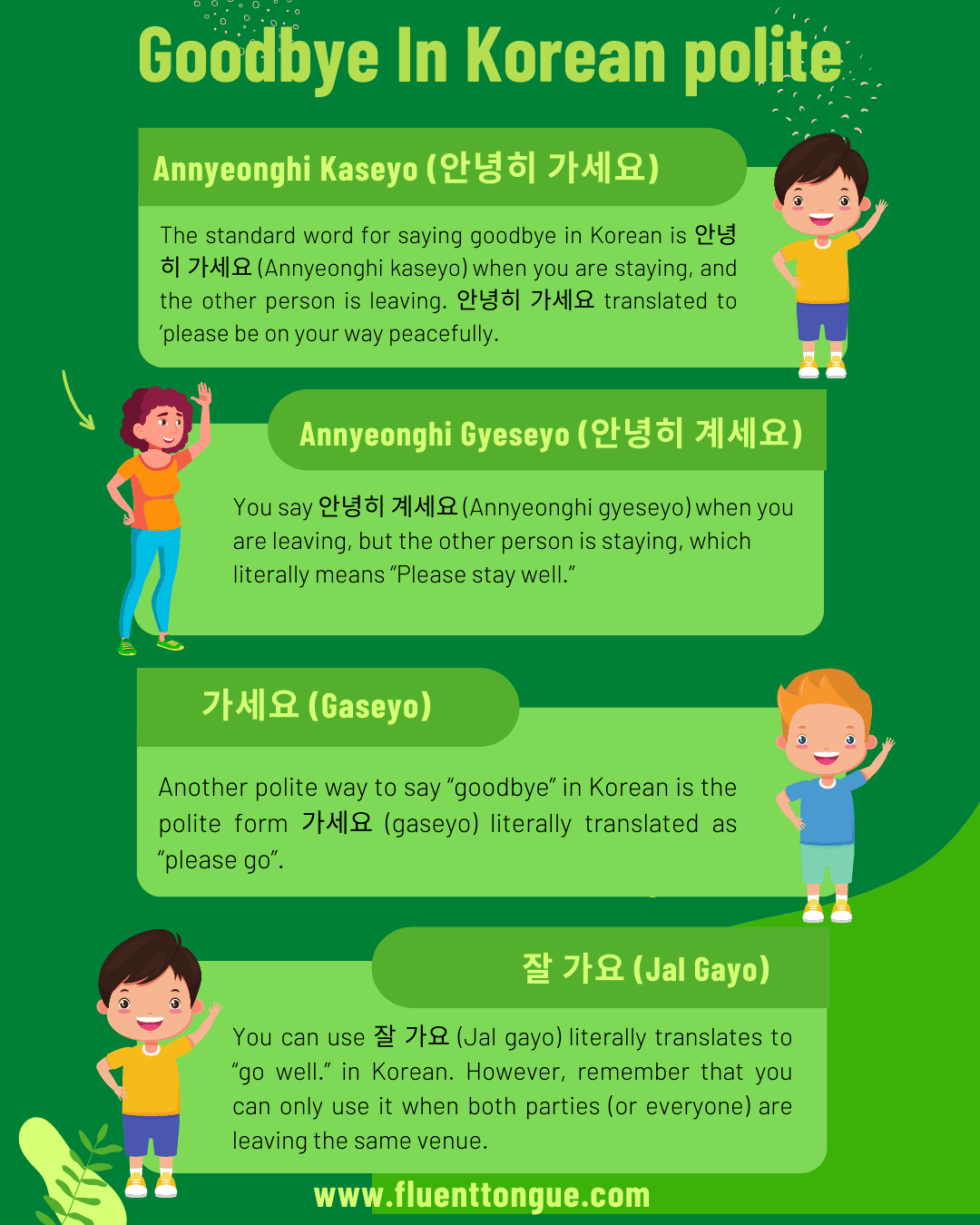
To say goodbye in korean is at all times a good suggestion to finish your conversations with mates or household in Korea.
안녕히 계세요(AnnyeongHi Gyeseyo) is the usual well mannered strategy to say goodbye in Korean when you’re the one leaving and actually interprets to “please keep properly.”. Then again, 안녕히 가세요 (An nyeong hello ga se yo) is used when you’re the one staying. It means “Please go properly.” 잘가 [jal-ga] This actually interprets to “bye (keep properly),” which you should use with your pals.
Here’s a record of the 9 methods to say bye in Korean relying on the opposite particular person’s age or how properly them.
- Informal – 잘 가 (Jal-ga)
- Well mannered – 안녕히 가세요 (annyeonghee gaseyo)
- Formal – 안녕히 가십시오 (annyeonghee gasipshio)
- Informal – 잘 있어 (Jal-isseo)
- Well mannered – 안녕히 계세요 (annyeonghee geseyo)
- Formal – 안녕히 계십시오 (annyeonghee gesipshio)
- Well mannered- 가세요 (gaseyo)
- Casual- 안녕 (annyeong)
- 끊을게요 (kkeunh eulgeyo)-bye” in Korean when ending a telephone name.
How are you in Korean| Asking somebody concerning the circumstances

You don’t get a second likelihood to make a primary impression, and realizing say “howdy” and “how are you in Korean” will make sure you get brownie factors.
Koreans don’t actually say How are you in Korean straight however you’ve heard 잘 지내셨어요? (jal jinaesyeosseoyo)?’. It has extra doubtless been, “How have you ever been?”
So, How To Say “How Are You In Korean?”
The interpretation of ‘How are you?’ in Korean is 잘 지내셨어요? (jal jinaesyeosseoyo)?’ means” ‘Have you ever lived properly?’. ‘잘’ means’ properly ‘and 지내셨어요? got here from the verb ‘지내다’means’ “to stay.” You too can say 잘 있었어요? (jal isseosseoyo) means “have you ever been properly?”. You’ll be able to solely use it with individuals however haven’t seen in a very long time.
As you possibly can see, it’s not a direct translation of ‘How are you?’ Not like English, simply say howdy and go straight to the purpose.
Right here’s a listing of say “How are you” in Korean from formal to casual.
- 잘 지내셨어요? (jal jinaesyeosseoyo?) – formal
- 안녕히 계셨어요? (annyeonghi gesyeosseoyo?) – formal
- 잘 있었어요? (jal isseosseoyo?) – normal well mannered
- 잘 지냈어? (jal jinaesseo?) – casual
- 잘 있었어? (jal isseosseo?) – casual
Earlier than you eat one thing
“잘 먹겠습니다” is a typical Korean expression used earlier than beginning a meal. It’s the equal of “Bon Appétit” or “Get pleasure from your meal” in English.
The literal translation of “잘 먹겠습니다” is “I’ll eat properly”.
One Of the attention-grabbing information about korea is that Korean specific gratitude by saying잘 먹겠습니다 for the meals that’s about to be consumed and to want for a nice eating expertise.
After you eat one thing
잘 먹었습니다 — Actually means “(I) ate (this) properly.” As you see, it’s the previous type of the previous one. 잘 먹겠습니다 is sooner or later tense as you had been earlier than consuming one thing.
Good morning in Korean

Are you prepared to start out your break day with a bang? Then you definitely’ll need to learn to greet others with a cheerful “good morning in Korean”
Talking “good morning in korean” isn’t just good manners, however additionally a dialog starter.
The literal translation of “good morning” in Korean language is 좋은 아침! (joeun achim)좋은 (joeun) means “good” and 아침 (achim) means “morning”.
However it’s awkward. Koreans typically don’t use greetings like that to say morning in Korea in every day life.
Koreans simply say “안녕하세요(howdy)” when wishing somebody a great day in Korean.
The usual strategy to say good morning in Korean is 좋은 아침이에요(joeun achimieyo). The interpretation of excellent morning in Korean is 좋은 아침 however Korean audio system don’t usually use it to say morning in Korean.
As an alternative, they merely say “안녕하세요”(howdy). The casual strategy to say good morning is 잘 잤어? (jal jasseo) means “Did you sleep properly?” with mates.
For elders, you should use the formal kind 잘 주무셨어요? (jal jumusyeosseoyo) or 안녕히 주무셨어요? (annyeonghi jumusyeosseoyo) to say good morning in Korea.
Listed below are the 7 most typical methods to say good morning in Korean language, relying upon politeness stage (the opposite particular person’s age) and conditions.
- 좋은 아침이에요(joeun achimieyo).
- 잘 잤어? (jal jasseo)
- 안녕히 주무셨어요? (annyeonghi jumusyeosseoyo).
- 주무셨어요? (jal jumusyeosseoyo)
- 잘 잤어요? (jal jasseoyo)
- 좋은 아침! (joeun achim)
- 좋은 아침입니다 (joeun achimimnida)
Good night time in Korean| Earlier than somebody go to mattress or sleep
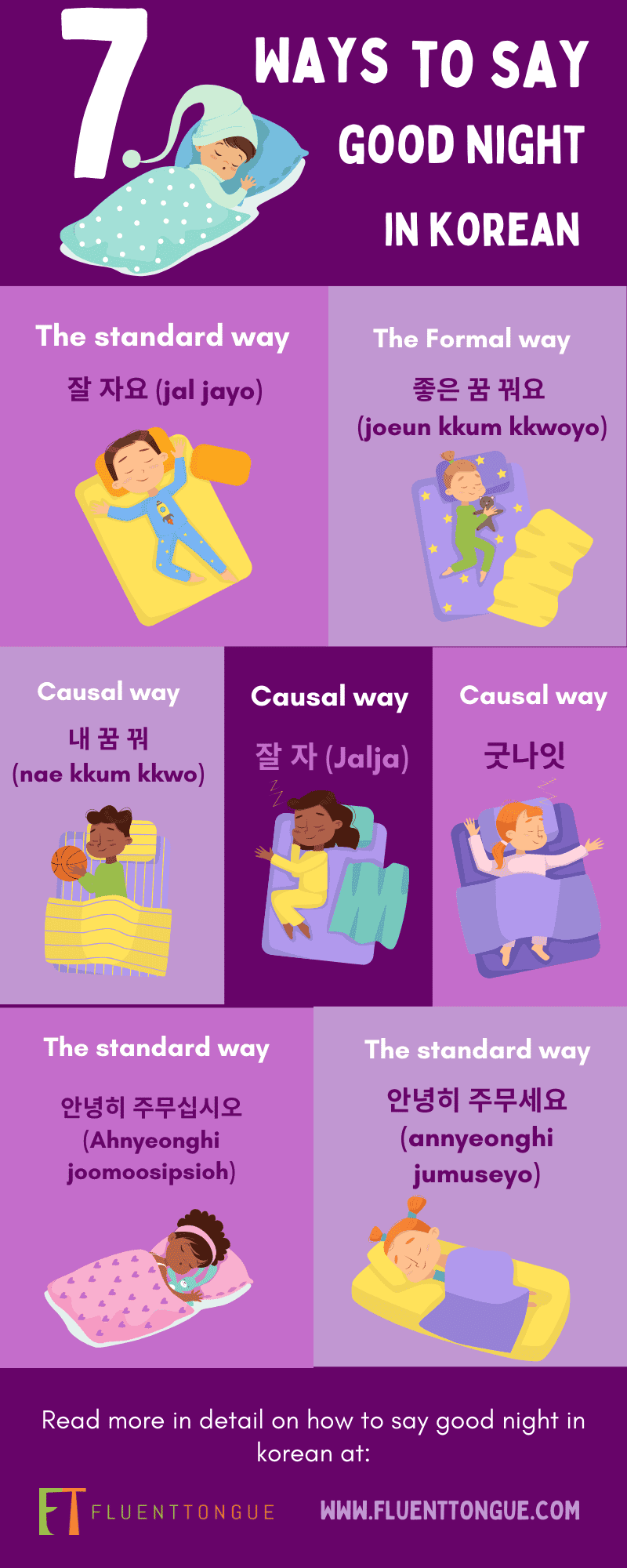
We have to sleep on daily basis and saying “goodnight” and “hello” in Korean is important, however say good night time in Korean.
And 안녕히 주무세요 (annyeonghi jumuseyo) is the usual and revered means of claiming good night time in korean means “sleep peacefully”. 잘 자요 (jal jayo) can also be the well mannered strategy to say good night time (made up 잘 (good/properly) and 자요 (verb 자다- to sleep)).
좋은 꿈 꿔요 (joeun kkum kkwoyo) additionally means good night time which translated as “have a candy dream”. you too can use 잘 자 (Jalja) with people who find themselves very near you or youthful than you.
Listed below are the 7 frequent methods to say “good night time” in Korean, relying upon politeness and state of affairs stage.
- 안녕히 주무세요 (annyeonghi jumuseyo)
- 잘 자요 (jal jayo)
- 좋은 꿈 꿔요 (joeun kkum kkwoyo)
- 안녕히 주무십시오(Ahnyeonghi joomoosipsioh)
- 잘 자 (Jalja)
- 내 꿈 꿔(nae kkum kkwo)
- 굿나잇
How you can say “See you subsequent time” in Korean
The commonest strategy to say “See you subsequent time” in Korean is “다음에 뵙겠습니다” (da-eum-e boepge-sseum-ni-da), which will be Romanized as “daeum-e boepkesseumnida”. This phrase is a well mannered and formal strategy to say goodbye, and it’s usually utilized in skilled or formal settings, akin to when ending a enterprise assembly or after assembly somebody for the primary time.
If you wish to say “See you subsequent time” in a extra informal setting, you possibly can say “다음에 봐” (da-eum-e bwa), which is a shorter and extra casual strategy to say the identical factor. This phrase is commonly used amongst mates, relations, and acquaintances, and it’s typically thought-about much less well mannered and formal than the earlier phrase.
또 means ‘once more’ and 봐요 is the well mannered type of 보다 which implies ‘to see’, so this phrase means ‘see you once more’, and there are additionally completely different variations of the identical phrase:
we will additionally say ‘so long’ in Korean and that is 또 봐요. 또 means ‘once more’ and 봐요 is the well mannered type of 보다 which implies ‘to see’, so this phrase means ‘see you once more’, and there are additionally completely different variations of the identical phrase: 나중에 또 봐요 (najoonge ddo bwayo)
나중에 봐요 (nachunge bwayo)-That is one other strategy to say “see you subsequent time” or “so long”. You’ll be able to take away the 요 to make it extra informal.
Thanks in Korean
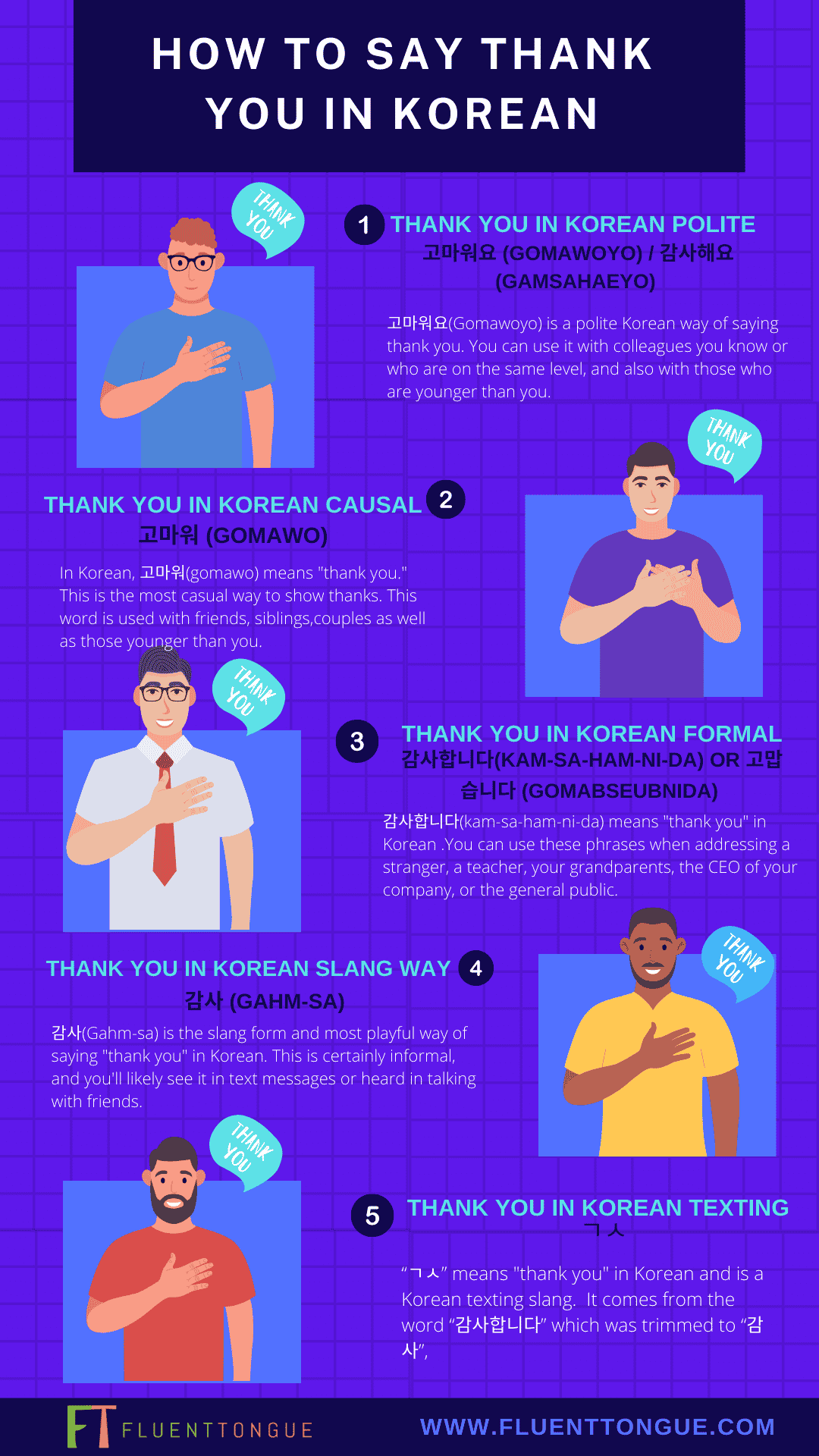
Saying howdy and thanks in Korean provides you extra energy(in a dialog)
While you present gratitude, it provides you a extra optimistic outlook, shares kindness, and naturally, makes individuals smile as properly.
Right here’s how
감사합니다(Kam-sa-ham-ni-da) means “thanks” in Korean and is the usual means. You need to use it to point out respect to strangers, aged individuals, and your boss at work. Koreans additionally use 고맙습니다(gomabseubnida) in all formal settings, whereas고마워 (gomawo) is informal which can be utilized with siblings, mates, in addition to these youthful than you. In well mannered conditions, you should use the phrases 고마워요 (gomawoyo)/ 감사해요 (gamsahaeyo) to point out appreciation
So, Right here is say thanks in Korean(formal & casual) in numerous conditions.
- Thanks in Korean casual – 고마워 (gomawo)
- Thanks in Korean well mannered – 고마워요 (gomawoyo) or 감사해요 (gamsahaeyo)
- Thanks in Korean formal – 감사합니다(kam-sa-ham-ni-da) or 고맙습니다 (gomabseubnida)
Need to know extra? Right here’s an in depth information on 7 methods to say “thanks” in Korean (from formal to casual) for you.
You’re welcome in Korean

In English, there are various alternative ways to answer when being thanked, akin to “You’re welcome, No drawback. Any time, Positive factor, My pleasure “and many others.
However Responding to “Thanks” in Korean will not be the identical as it’s in English.
However in Korean tradition, the phrase “you might be welcome” will not be that frequent.
Nonetheless, there are a number of methods to say “you’re welcome” in Korean. The commonest is “아니야” and “아니에요 means “It’s nothing/no drawback,” or you possibly can merely reply by saying “Sure” with “네” or the extra informal “예”.
In textbooks, they let you know that You’re welcome interprets to 천만에요.No one makes use of it anymore.
Right here‘s Say You’re Welcome in Korean and three frequent methods to answer to thanks in Korean.
- (Well mannered) 아니에요 (anieyo) – under no circumstances.
- 천만에요 (cheonmaneyo)– you’re welcome,
- {Formal} 별말씀을요 – don’t point out it.
To sound much more like Korean, add 에이… in entrance of these like 에이, 아니예요. It means “Nahhh, it’s nothing”. That Nahhh provides an entire lot of taste to it.
아니에요 (Anieyo)– It’s Nothing/ IT’S OKAY
아닙니다 or 아니예요 means It’s nothing/no drawback/it’s okay. It’s a well mannered and oblique strategy to say You’re Welcome in Korean. Nonetheless, you should use the causal from “아니야, 아냐 (a shorter model)” for speaking to a buddy or somebody youthful than you. 아닙니다( Anipnida) is the formal and well mannered strategy to reply to thanks in Korean. Simply use 괜찮아요/아니에요/” for speaking to individuals older than you.
Right here is say you might be welcome in Korean in formal, informal, and well mannered conditions.
- Informal way- 아니야. aniya
- casual, plainly well mannered – 아니에요. anieyo (actually means “no”)
- Formal and well mannered – 아닙니다. anipnida [animnida]
천만에요 (Cheonmaneyo)- YOU ARE WELCOME IN Korean
“천만에요(cheonmaneyo)” in Korean means “You might be welcome.” In at present’s Korea, nobody ever says that in real-life conversations. It’s a phrase from a highschool textbook. You’ll be able to simply say,아니에요. and it’ll sound much more pure when somebody says thanks in Korean.
별말씀을요 (Byeolmalsseumeullyo)- DON’T MENTION IT
‘별말씀을요’ means ‘don’t point out it. This phrase is formal and extra generally used than 천만에요.
Excuse me in Korean

To say “Excuse me in Korean”, you’d say “실례합니다” (pronounced: shil-le-hap-ni-da). Use this helpful phrase when you could seize somebody’s consideration or while you need to express regret for a small mishap.
you’re in a crowded place and must squeeze previous somebody, or perhaps you’re making an attempt to catch the attention of that busy shopkeeper. The magic phrases are “잠시만요”, pronounced “jam-shi-man-yo”. It’s like saying “Only a second, please” in English.
Fairly helpful, proper?
And don’t overlook about “여기요” (yeogiyo) and “저기요” (jeogiyo). These two are your go-to phrases for calling somebody over, whether or not it’s to order one other spherical of kimchi pancakes at your favourite restaurant or to ask for instructions within the bustling streets of Seoul.
Please notice that the extent of politeness within the Korean language is sort of necessary, and these are the extra well mannered variations of “Excuse me”.
At all times take into account the context and the connection you’ve with the particular person you’re talking to.
Right here’s Say Excuse Me in Korean in 5 alternative ways together with formal, normal, and casual expressions.
- Normal “Excuse Me” in Korean – 잠깐만요 (jamkkanmanyo) / 잠시만요 (jamsimanyo)
- Casual “Excuse Me” in Korean-잠깐만 (jamkkanman) / 잠시만 (jamsiman)
- Formal “Excuse Me” in Korean – 실례합니다 (sillyehamnida)
- 여기요 (yeogiyo) and 저기요 (jeogiyo)- when making an attempt to get any individual’s consideration
- 죄송합니다 (joesonghamnida) – To Ask A Favor
Good to fulfill you in Korean
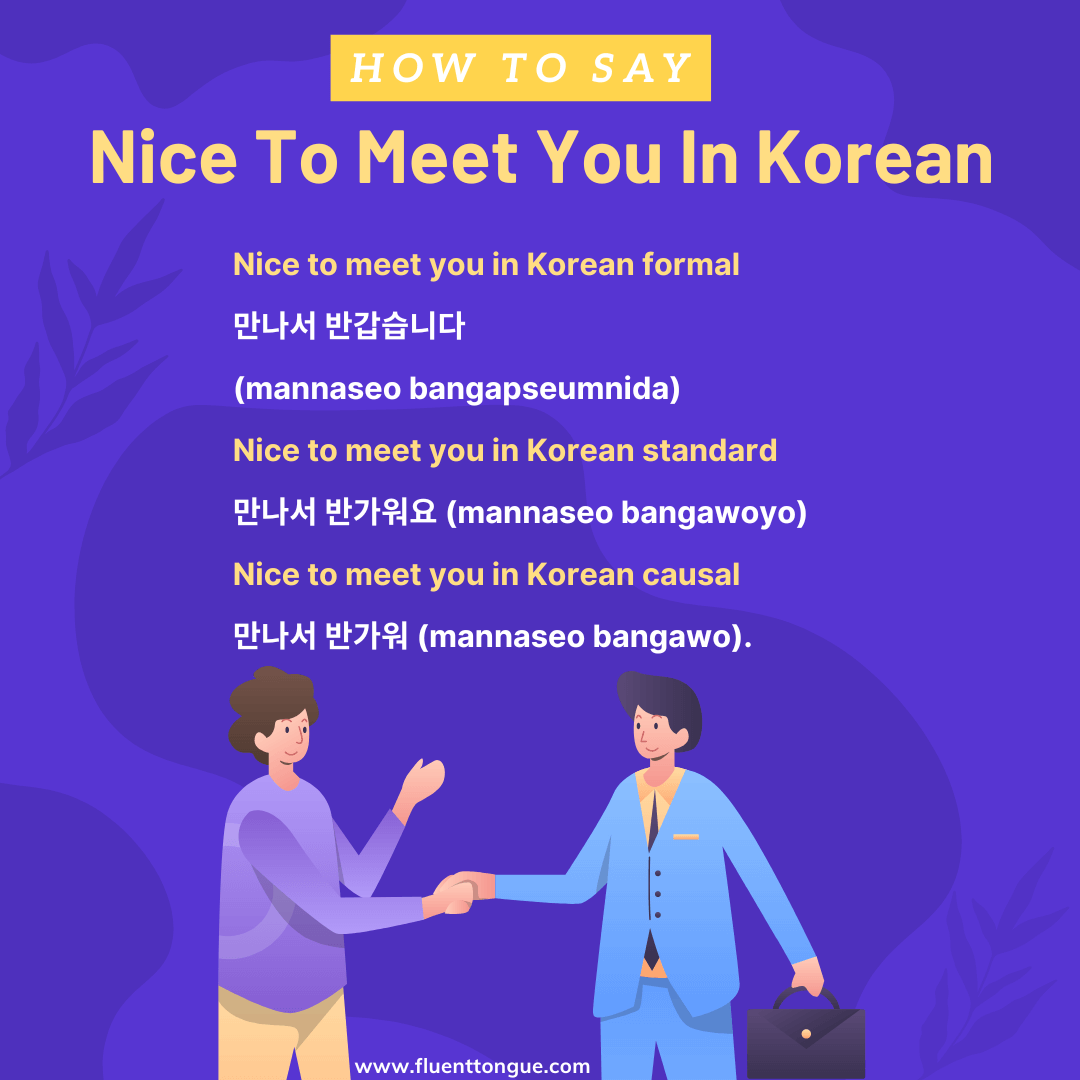
What did you say while you met somebody for the primary time?
Nicely, one thing like Hello, how are you or Good to fulfill you in Korean. (if you’re in Korea)
However how do you say good to fulfill you in Korean?
To say good to fulfill you in Korean, you possibly can say 만나서 반가워요 (mannaseo bangawoyo). It’s made up of two phrases akin to 만나다(mannada) means “to fulfill” and 반갑다(bangapda) means “to be pleased”. 만나서 반갑습니다 (mannaseo bangapseumnida), which implies “good to fulfill you in Korean formal means. With mates, you should use the causal means 만나서 반가워 (mannaseo bangawo).
Right here’s say good to fulfill you in Korean in 3 alternative ways relying on the extent of ritual.
- good to fulfill you in Korean formal-만나서 반갑습니다 (mannaseo bangapseumnida),
- good to fulfill you in Korean standard-만나서 반가워요 (mannaseo bangawoyo)
- good to fulfill you in Korean causal-만나서 반가워 (mannaseo bangawo).
Please Give Me In Korean- 주세요 (Juseyo)

주세요 [ju-se-yo] means ‘Please give me’ in Korean which comes from the verb 주다, which implies “to provide”, and the well mannered ending ~(으)세요). You need to use this phrase while you need to ask for issues in Korean.
To make use of 주세요 (juseyo) in Korean sentences, You merely add the phrase for the factor that you really want somebody to provide you earlier than 주세요.
The essential construction to say Please Give Me’ In Korean[주세요 (juseyo)] is
[Thing you want given or passed] + “주세요 (juseyo)”
For instance, in order for you some beer you merely say 맥주 (beer) + 주세요 (please give me) = 맥주 주세요 [maegju ju-se-yo] (Please give me a beer).
- Please give me a coke = 콜라 주세요= 콜라(coke) + 주세요
- Please give me water = 물 주세요= 물(water) + 주세요
- Please give me that = 그거 주세요= 그거(that) + 주세요
- Please give me kimbap=김밥 주세요= 김밥(kimbap) + 주세요
- Please clarify it to me.= 설명해주세요= 설명하라(clarify) + 주세요
- Please settle for my reward = 선물을 받아주세요= 설명(reward) + 주세요
- Please give me cash=돈 주세요= 돈(cash) + 주세요
- Please give me cigarette=담배 주세요= 담배(cigaratte) + 주세요
You too can be used after the verb for instance
Please present me
보여주세요
Let me clarify with examples
Please assist me
도와주세요
Please be wholesome everybody
모두 건강하세요
Please give me an concept
아이디어를주세요
Very long time no see in Korean
The usual and well mannered strategy to specific “Very long time no see” in Korean is “오랜만이에요” (oraenmanieyo). If you wish to use a extra casual strategy to say this phrase, you should use “오랜만이야” (oraenmaniya) as an alternative.
The casual expression can be utilized with your loved ones, mates, and people who are near you.
“오랜만이다” (orenmanida) is the formal strategy to say “Very long time no see” in Korean.
Instance
Wow, it’s been a extremely very long time.
와 진짜 오랜만이다
It’s been a very long time. Have you ever been good?
오랜만이에요. 잘 지내셨어요?
minho, very long time no see.
민호 씨, 오랜만이에요.
It’s been ages since we went tenting.
우리가 캠핑 다녀온 뒤로 정말 오랜만이다.
Mirae, it’s been so lengthy.
미래야, 진짜 오랜만이야
“Oh, my god! It’s been ages.” “Wow! You look attractive!”
“오, 어머나! 오랜만이다.” “와, 너 멋지다!”
Saying Sorry in Korean
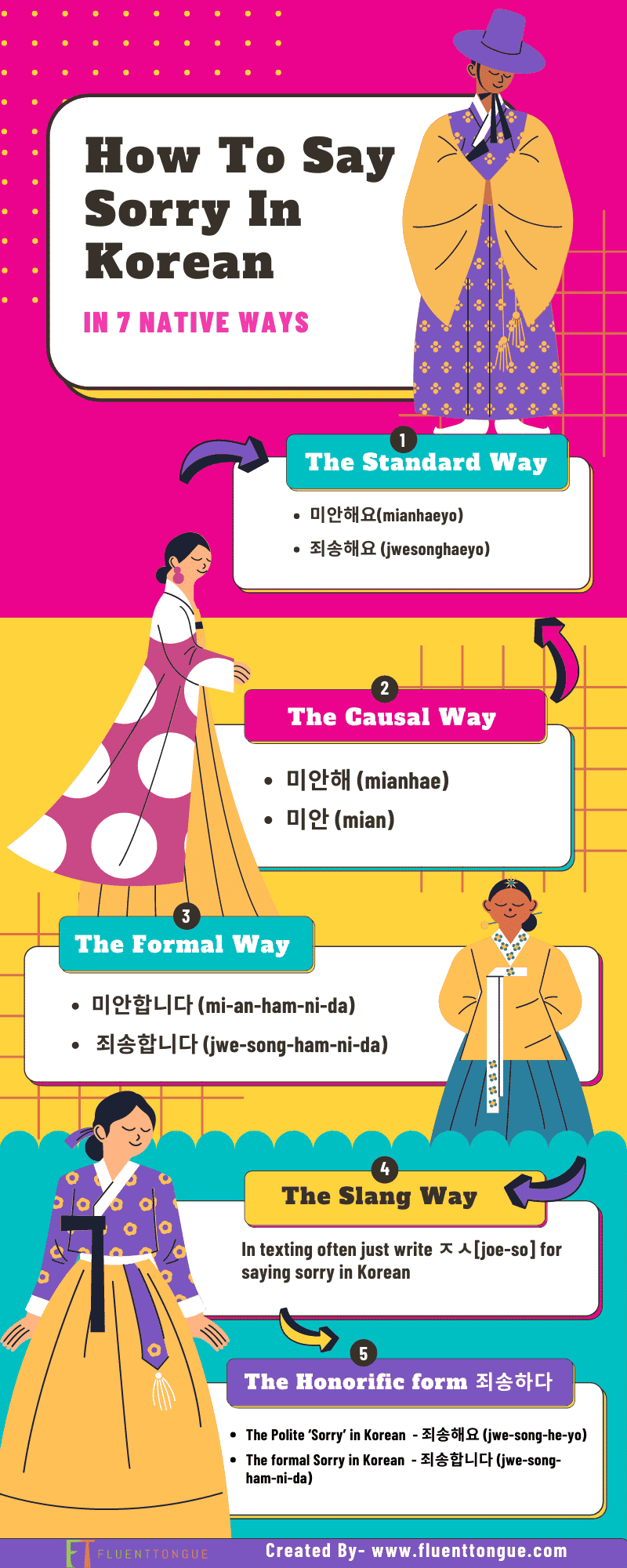
죄송합니다 (jwe-song-ham-ni-da) is the essential and formal strategy to express regret in Korean. You too can use 미안해요 (mi-an-hae-yo) or 죄송해요 (jwe-song-he-yo) to apologize in Korean politely. Nonetheless, whereas apologizing to mates/ informal conditions, simply use 미안해 (mi-an-he) or 미안(mi-an).
죄송합니다 (jwe-song-ham-ni-da) and 미안해요 (mi-an-hae-yo) are almost the identical.
however
The one distinction between 죄송합니다 (jwe-song-ham-ni-da) and 미안해요 (mi-an-hae-yo) is that “죄송합니다” comes from a sino Korean phrase “죄송[]” and sounds extra respectable to specific sorry than the opposite. 미안해요 is ceaselessly used amongst informal mates and coworkers.
Right here is How you can Say ‘I’m Sorry’ in Korean ( casual, formal, and well mannered methods) and phrases you could know to be able to apologize in Korean like a local Korean speaker.
- Normal ‘Sorry’ in Korean -죄송해요 (jwesonghaeyo) or 미안해요(mianhaeyo)
- Sorry in Korean casual -미안해 (mianhae) or simply 미안 (mian)
- Sorry in Korean formal -미안합니다 (mi-an-ham-ni-da) / 죄송합니다 (jwe-song-ham-ni-da)
Sure in Korean|If you end up agree with somebody

The commonest strategy to say “sure” in Korean is “네(ne)” and the opposite means is to say ” 예 (Ye)”. However you possibly can say the Korean phrase for sure 응 [eung] or 엉 [ung], if you wish to say “sure” in causal conditions.
- 네 [Ne]—Normal Manner To Say Sure In Korean
- 예 [Ye] – Politer/Extra Formal Manner To Say Sure In Korean
- 응 [Eung]- Casual and Cute Manner Of claiming Sure In Korean language(Used By Girls)
- 엉 [Ung] – The Korean phrase for Sure In an off-the-cuff means (Used By Males)
No in Korean| If you end up disagree
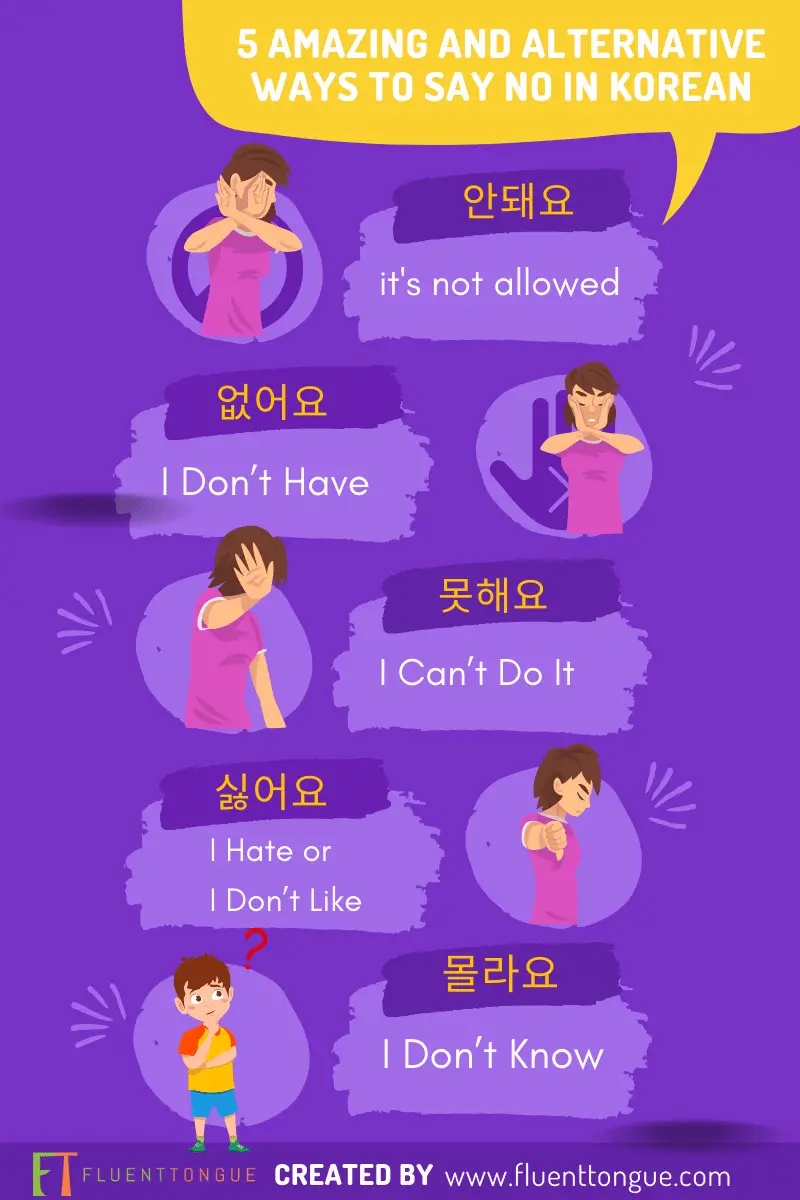
Politeness is a must have in Korean tradition.
There are simply instances when we have now to disagree or give them unfavourable solutions, however if you happen to don’t need to be impolite, then you possibly can simply use this phrase.
Essentially the most normal strategy to say no in Korean is 아니요 (a-ni-yo) and it comes from the Korean verb 아니다[ a-ni-da] which accurately means “to be not”. To say “no” in a extra informal means, you possibly can drop the 요 ending and simply say 아니 (a-ni).
Listed below are the frequent methods to say no in Korean language with hangul and romanization whereas conveying what you could.
- The usual strategy to say no in korean-아니요 (a-ni-yo)
- Casual strategy to say no in korean – 아니 (a-ni)
- Formal strategy to say no in korean – 아닙니다 [ ah-neem-nee-dah]
Congratulations in Korean
‘Congratulations’ within the Normal Well mannered Casual Kind is 축하해요! For the informal/casual kind, you’ll merely say 축하해. With the formal kind, you’d use 축하합니다! Use this with individuals older than you. You’d additionally use this to congratulate somebody on their wedding ceremony or commencement. For the very formal kind, you’d use 축하드립니다! Use this with bosses, academics, or on the whole individuals with positions of energy over you within the office.
Congratulations in your promotion. You might be on the quick monitor.
진급을 축하합니다.
Congrats in your new child!
출산을 축하합니다.; 아기 탄생을 축하해요.
Congratulations! I’m so pleased for you.
축하해! 네가 잘 되어서 정말 행복해.
Joyful birthday! Hope you’re having a good time in Canada!
생일 축하해! 캐나다에서 좋은 시간 보내고 있길 빌어!
Joyful birthday (to you)!
생일 축하합니다!
‘We’re getting married!’ ‘Congratulations!’
“우리 결혼해요!” “축하해요!”
Congratulations in your promotion to assistant supervisor.
대리로 승진하신 것을 축하드립니다.
Congratulations, I hear you’re going to have a child!
축하해요. 곧 아이가 태어날 거라면서요.
Congratulations in your new job. When do you begin?
새 직장 얻은 거 축하해요. 언제부터 출근해요?
Okay in korean
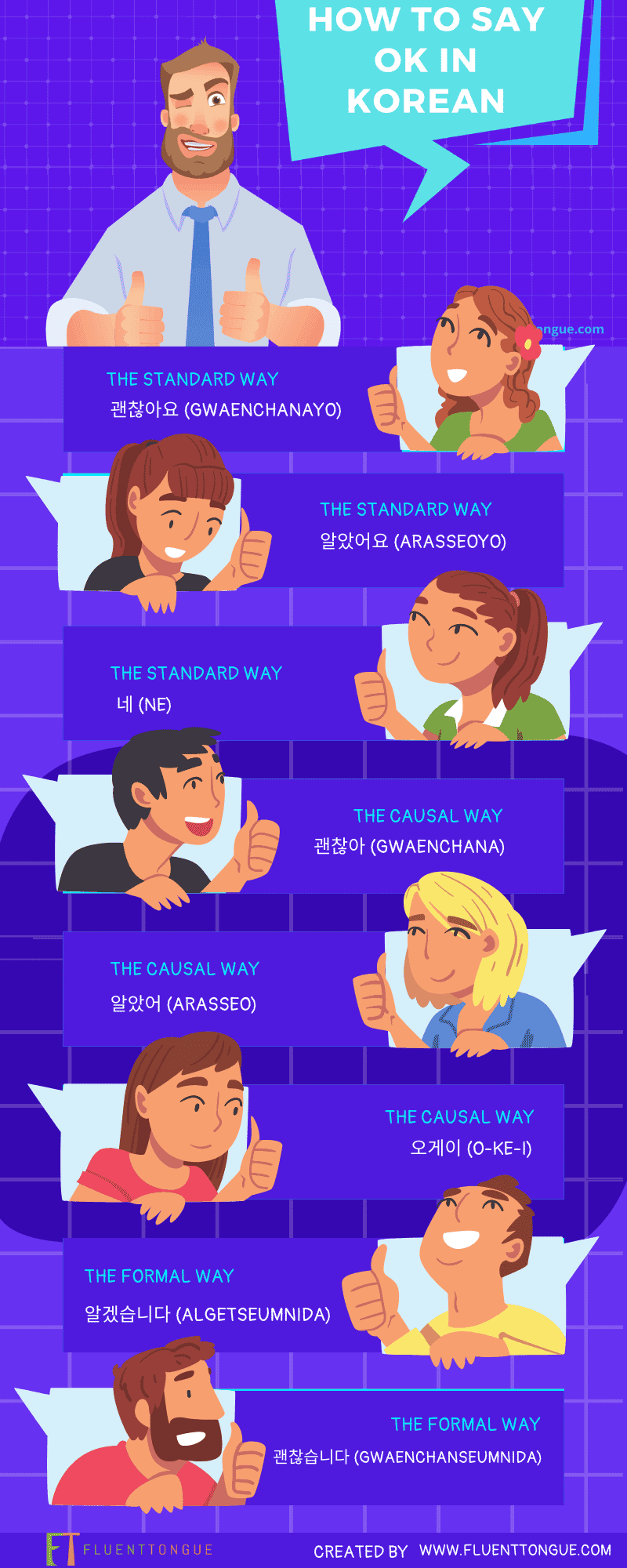
괜찮아요 (gwaenchanayo) is the most typical means of claiming ‘OK’ or ‘Are you OK? The closest and casual strategy to translate “okay” in Korean is 괜찮아 (gwaenchana). You employ this with mates, siblings, or individuals youthful than you. However typically individuals say “sure” in Korean 네 (ne) to point out their settlement .알았어요 (arasseoyo) additionally means “okay, I do know” in Korean.
Listed below are the ten most typical methods to say okay in Korean language, relying upon politeness stage and conditions.
- 괜찮아요 (Gwaenchanayo)
- 알았어요 (Arasseoyo)
- 네 (ne)
- 괜찮아 (Gwaenchana)
- 알았어 (arasseo)
- 응 (eung)
- 오게이 (o-ke-i)
- 괜찮습니다 (gwaenchanseumnida)
- 알겠습니다 (Algetseumnida)
- ㅇㅋ
Let’s go- kaja가자
Isn’t it thrilling while you lastly grasp a brand new phrase in a overseas language? Take “Let’s go” in Korean, as an example. The phrase is “가자”, pronounced “kaja”.
It’s fairly easy and can be utilized in so many contexts.
Let’s check out 5 instance sentences:
음식이 왔어요. 가자!
The meals is right here. Let’s eat!
이번 주말에 여행 가자!
Let’s go on a visit this weekend!
영화 시작됐어요. 가자!
The film has began. Let’s watch!
쇼핑하러 가자!
Let’s buy groceries!
집에 돌아가자!
Let’s go dwelling!
I don’t perceive
To say “I don’t perceive” in Korean, you’d say “이해가 안 돼요”, which is pronounced, “ihaega an dwaeyo”.The Korean phrase “모르겠습니다” (mo-reu-get-seup-ni-da) is a well mannered strategy to specific “I don’t know” or “I’m unsure”.
Listed below are a number of cases of how you would use it in a dialog:
“이 문제에 대해 모르겠습니다.” – “I don’t find out about this drawback.”
“그 사람을 모르겠습니다.” – “I don’t know that particular person.”
“다음 단계를 모르겠습니다.” – “I’m unsure concerning the subsequent step.”
“어떤 책을 선택해야 할지 모르겠습니다.” – “I’m unsure which e book to decide on.”
“어떤 길로 가야 할지 모르겠습니다.” – “I’m unsure which strategy to go.”
“이해가 안 돼요.” – “I don’t perceive.”
“한국어가 잘 이해가 안 돼요.” – “I don’t perceive Korean properly.”
“그 말은 이해가 안 돼요.” – “I don’t perceive what you’re saying.”
“그 지시를 이해가 안 돼요.” – “I don’t perceive the directions.”
“그 문제를 이해가 안 돼요.” – “I don’t perceive that drawback.”
So, subsequent time you’re unsure about one thing in a Korean dialog, “모르겠습니다” is your go-to phrase!
How a lot is that this?
While you need to ask “How a lot is that this?” in Korean, you’d say “이것은 얼마입니까?(igeoseun eolmaimnikka?)” or “이거 얼마예요?
This phrase is fairly useful, particularly while you’re buying and must inquire concerning the value of one thing!
Right here’s say “How a lot is that this” In formal, well mannered and informal conditions.
- Formal: “이것은 얼마입니까?” – “How a lot is that this?”
- Well mannered: “이거 얼마예요?” – “How a lot is that this?”
- Casual: “이거 얼마야?” – “How a lot is that this?
Listed below are superior instance sentences
이 책은 얼마입니까?
How a lot is that this e book?
이 신발 얼마예요?
How a lot are these sneakers?
그 옷 얼마야?
How a lot is that garments?
이 커피 얼마입니까?
How a lot is that this espresso?
그 가방 얼마예요?
How a lot is that bag?
What’s your identify
In Korean, if you wish to ask somebody “What’s your identify?”, there are alternative ways to specific it relying on the extent of ritual.
Let’s break it down.
The casual strategy to ask “What’s your identify?” in Korean is “이름이 뭐야?” [i-reum-i mwo-ya]. This expression is used when speaking to somebody a lot youthful than you, like youngsters. It’s an informal and relaxed strategy to ask for his or her identify.
For many conditions, the well mannered strategy to ask “What’s your identify?” is “이름이 뭐예요?” [i-reum-i mwo-ye-yo]. That is the expression you possibly can safely use within the overwhelming majority of conditions. Ending with “예요” makes it a well mannered kind. It conveys respect and politeness, making it appropriate for many interactions.
Nonetheless, in formal conditions or when addressing somebody a lot older than you, akin to in enterprise conferences, it’s greatest to make use of the formal expression. The formal strategy to ask “What’s your identify?” is “성함이 어떻게 되세요?” [seong-ham-i eo-tteo-ke doe-se-yo]. This expression is taken into account extra respectful and applicable in formal contexts.
When requested on your identify in Korean, you possibly can reply utilizing these frequent methods. Simply exchange the highlighted half together with your identify to say “My identify is…” in Korean.
Instance
I’m Mi Rae.
[저는 미래에요.]
I’m Mi Rae.
[저는 미래입니다.]
My identify is Mi Rae.
[제 이름은 미래에요.]
My identify is Mi Rae.
[제 이름은 미래입니다.]
“Please Look After Me” in Korean
The phrase “Please Look After Me” will be translated to “잘 부탁드립니다” in Korean.
You need to use this whereas talking to somebody greater than you.
South Korean Greetings for the vacations
South Korea has a wealthy cultural heritage and celebrates numerous conventional holidays all year long, every with its distinctive customs and traditions.
Throughout these holidays, exchanging greetings is a vital a part of the celebrations. South Korean greetings usually convey heat needs for good well being, prosperity, and happiness.
On this article, we’ll introduce among the most typical South Korean greetings for holidays, together with New 12 months’s Day, Lunar New 12 months, Harvest Pageant, Christmas, and extra.
Whether or not you’re visiting or residing in South Korea, realizing these vacation greetings will assist you to join with the native individuals and immerse your self of their wealthy cultural traditions.

Joyful New 12 months in Korean
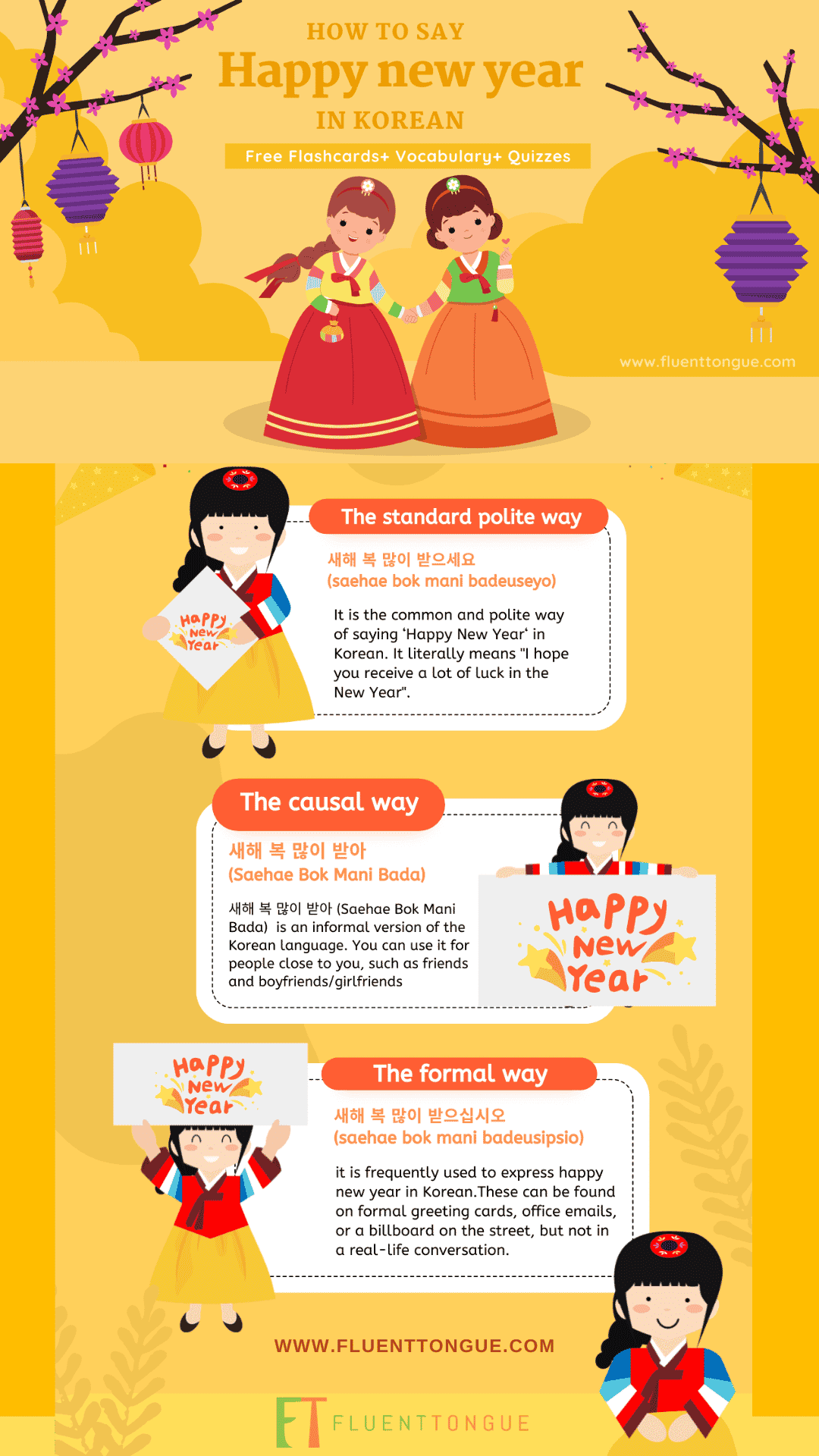
Koreans rejoice the photo voltaic new 12 months (1st January) and lunar new 12 months (selloal) yearly. Korean pleased new 12 months date varies relying on photo voltaic or lunar calender.
In case you have family and friends whom you need to want for? Or just need to learn to say pleased new 12 months in Korean like a local.
It’s time to brush up in your Korean New 12 months greetings!
The best strategy to say pleased new 12 months in Korean language is 새해 복 많이 받으세요 (saehae bok mani badeuseyo) means “I want you good luck within the New 12 months.” 새해 (saehae) interprets to ‘new 12 months,’ 복(bok) to ‘luck,’ and 많이 (mani) to quite a lot of.’ 새해 복 많이 받아(Saehae Bok Mani Bada) is an off-the-cuff means of wishing somebody a cheerful new 12 months in Korea. Merely say the phrases 새해 복 많이 받으십시오 (saehae bok mani badeusipsio) to make it extra formal.
Right here’s say a cheerful new 12 months in Korean (casual, well mannered, formal means) appropriately together with their hangul and romanization.
- The usual well mannered way- 새해 복 많이 받으세요 (saehae bok mani badeuseyo)
- The causal means -새해 복 많이 받아 (Saehae Bok Mani Bada)
- The formal means – 새해 복 많이 받으십시오 (saehae bok mani badeusipsio)
Korean Lunar New 12 months greetings
simply saying “Joyful New 12 months in Korean language” by itself may sound a bit uninteresting.
In actual fact, Korean used a variety of completely different expressions.
So if you wish to impress your pals together with your language ability, combine and match all of the Korean greetings you’ll study now and add them after Korean New 12 months greetings to make them a little bit fancier.
So, listed here are different Korean New 12 months greetings you can take into account.
- I want you all one of the best within the new 12 months
- 새해에는 좋은 일만 가득하길 바래.- saehaeeneun joeun ilman gadeukagil barae
- Everybody, be wealthy.
- 모두 부자가 되세요- modu bujaga dweseyo
- I hope all the pieces you do will go properly
- 당신이 하는 모든 일이 잘 되길 바랍니다.
- Have a terrific winter trip!
- 겨울 방학 잘 보내세요! – gyoul banghak jal bonaeseyo
- Joyful new 12 months and at all times be pleased.
- 새해 복 많이 받으시고 항상 행복하세요
- How outdated are you this 12 months?
- 올해 몇 살이에요?olhae myot sarieyo
- What’s your plan this 12 months?
- 올해 계획이 뭐예요?olhae gyehwegi mwoeyo
- Please keep wholesome in coming 12 months too
- 내년에도 건강하세요- naenyonedo gonganghaseyo
- Joyful holidays!
- 행복한 휴일 보내세요!haengbokan hyuil bonaeseyo
Chuseok (Korean thanksgiving) greetings
Chuseok, often known as Korean Thanksgiving Day, is likely one of the largest and most necessary holidays in Korea.
It’s a time when households and mates collect collectively to provide thanks, pay respect to their ancestors, and share conventional Korean meals and drinks.
One of many methods to specific your good needs throughout this special day is by saying “Joyful Chuseok!” in Korean.
Nonetheless, there are various alternative ways to convey this message, every with its distinctive nuances and expressions of heat and sincerity.
On this article, we’ll discover 10 methods to say Joyful Chuseok in Korean, together with their meanings and contexts, in an effort to greet your Korean mates and family members in a means that’s each genuine and heartwarming.
1.즐거운 추석 되세요. (Have a Joyful Chuseok).
2. 추석 연휴 잘 보내세요. (Have a terrific Chuseok vacation.)
3. 해피 추석 되세요. (Joyful Chuseok!)
4. 즐거운 한가위 되세요. (Have a Joyful Hangawi.)
5. 즐겁고 풍성한 한가위 되세요. (Have a Joyful and Affluent Hangawi.)
6. 가족과 함께 풍성하고 즐거운 추석 보내시길 바랍니다. (Have a Joyful and affluent Chuseok together with your faimly.)
7. 마음이 풍요로운 행복한 한가위 보내세요. (Want you’ve a cheerful Chuseok that enriches your coronary heart and thoughts.)
8. 밝은 보름달처럼 넉넉한 한가위 명절 보내세요h. (Have a affluent Chuseok like the brilliant full moon.)
9. 명절인데도 찾아뵙지 못하여 죄송하오며 내내 행복하고 건강하시기를 기원합니다. (It’s unlucky that I’m not capable of want you in particular person on Chuseok however I want you everlasting good well being and happiness.)
10. 가정에 언제나 늘 한가위 같이 풍성하고 평화롭기를 바랍니다. (I want that this Chuseok brings everlasting prosperity, happiness, and bliss to your loved ones.
Korean Christmas greetings

Christmas in Korean language is translated as 성탄절 (seongtanjeol).성(Seong), is the Chinese language character which means “holy”,탄(Tan) means “beginning.” and 절 means vacation. So collectively 성탄절(seongtanjeol) means “the festive day the holy particular person was born.”
You too can say the mortgage phrase 크리스마스 (keuriseumaseu) to say merry christmas in south Korean
The frequent strategy to say Merry Christmas in Korean is 크리스마스 잘 보내세요 (keu-ri-seu-ma-seu jal bo-ne-say-yo).it’s made up of the phrases 크리스마스 (Christmas), which implies ‘properly,’ and 보내세요 means ‘please spend time.’ it actually means ‘Please spend Christmas properly’. you should use the informal kind 메리 크리스마스 (meri keuriseumaseu)/크리스마스 잘 보내 (keuriseumaseu jal bonae) with mates. 행복한 크리스마스 되십시오 (haengbokan keuriseumaseu doesipsio)is probably the most formal strategy to want somebody a Merry Christmas.
Right here’s say Merry Christmas in Korean language in addition to its pronunciation and hangul.
- The usual way- 크리스마스 잘 보내세요 (keu-ri-seu-ma-seu jal bo-ne-say-yo)./즐거운 성탄절 보내세요 (jeulgeoun seongtanjeol bonaeseyo)
- The casual way-메리 크리스마스 (meri keuriseumaseu)/크리스마스 잘 보내 (keuriseumaseu jal bonae)
- The formal way- 행복한 크리스마스 되십시오 (haengbokan keuriseumaseu doesipsio)/
Korean greeting gestures
5.1 Korean bow:
The Korean bow is a standard gesture of respect and gratitude. It includes bowing the top whereas retaining the again straight and the eyes centered on the bottom. There are two principal kinds of bows in South Korea: the informal bow and the respectful bow.
5.1.1 Informal bow:
The informal bow, generally known as ‘jejere’ in Korean, is a fast nod of the top and shoulders. It’s usually used to greet mates, household, and colleagues in casual settings. The depth of the bow varies primarily based on the connection between the 2 people.
5.1.2 Respectful bow:
The respectful bow, generally known as ‘jeol’ in Korean, is a deeper and extra formal bow. It’s usually used to point out respect to elders, and superiors, or in solemn conditions, akin to funerals or weddings. The depth of the bow is decided by the social standing of the particular person being bowed to, with deeper bows being reserved for these with greater standing.
5.2 Korean handshake:
Whereas not as conventional because the bow, the handshake has turn into a extra frequent greeting in South Korea, particularly in enterprise settings. The Korean handshake is often lighter and fewer agency than the Western handshake, and it could be accompanied by a slight bow of the top. It is very important do not forget that bodily contact is much less frequent in South Korea than in lots of Western international locations, and a few individuals could also be uncomfortable with a handshake.
How you can keep in mind korean greetings simply?
I do know saying “greetings in Korean language” is a bit complicated and so some ways make it even tougher to recollect.
however with follow and time, you will be nearly as good as native Korean audio system.
In spite of everything, in terms of fluency, follow is the important thing.
Right here’s how I did it.
I hope these assets will assist you to grasp greetings in Korean very quickly.
Anki Isn’t The Solely Sport In City.
Do you know you possibly can sing a tune and grasp Korean greetings with out lifting a finger?
Nicely, what may very well be higher than that?
Right here is how Koreans do it on a regular basis (now you are able to do it too!!!)
Use Flashcard And Check
Possibly drama will not be your factor. What about flashcards?
I do know it’s an outdated factor(you is likely to be utilizing Anki too)
However In terms of mastering Korean vocabulary, you’ll by no means remorse utilizing these fellas.
Right here is the record
https://flashcardo.com/korean-flashcards/
https://www.flashcardmachine.com/korean-greetings.html
https://quizlet.com/103431022/korean-greetings-flash-cards/
https://quizlet.com/search?question=korean-greetings&sort=units
Conclusion
There you’ve it- A listing of frequent greetings in Korean
By now, try to be a professional at impressing your Korean mates and colleagues together with your spectacular assortment of Korean greeting phrases.
Whether or not it’s a easy “Annyeong-haseyo” or a extra adventurous “Katchi Kapshida!”, you’ll you’ll want to make a long-lasting impression.
Keep in mind, follow makes excellent, so go on the market and greet everybody in your path together with your newfound abilities.
However, watch out to not overdo it, you don’t need to be generally known as the one who greets everybody with “Sarang-hae” (I really like you) within the workplace, until after all you actually do love all of them.
Thanks for becoming a member of us on this journey of mastering the artwork of Korean greetings and don’t overlook to come back again for extra suggestions and methods to enhance your language abilities.
Joyful studying.


